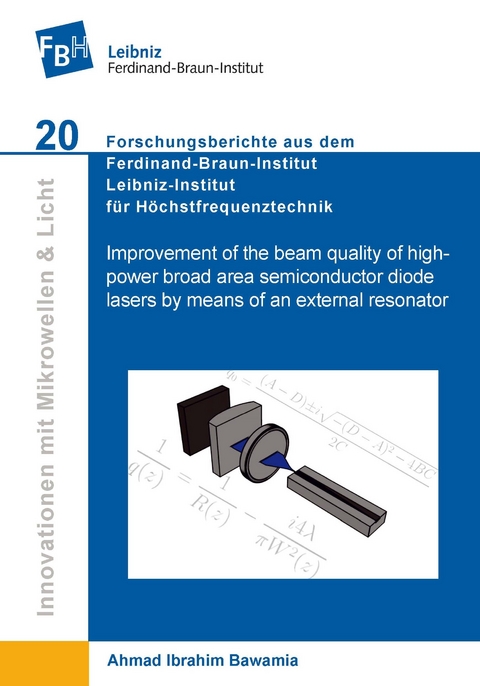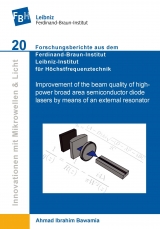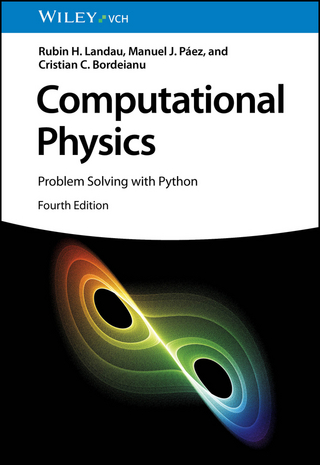Improvement of the beam quality of high-power broad area semiconductor diode lasers by means of an external resonator
Seiten
2012
|
1., Aufl.
Cuvillier, E (Verlag)
978-3-95404-065-0 (ISBN)
Cuvillier, E (Verlag)
978-3-95404-065-0 (ISBN)
- Titel ist leider vergriffen;
keine Neuauflage - Artikel merken
The operation of high-power broad area laser diodes in an external resonator is studied with respect to the improvement of their lateral beam quality. A simple setup with a broad area laser diode as gain medium, two lenses and an external mirror is considered. The concept relies on the ability of the active region of the laser diode to act as a spatial filter for higher order modes oscillating inside the resonator.
The geometries of the external cavity laser that favor fundamental mode operation in the lateral direction are inferred with the help of a theoretical model based on the ABCDmatrix treatment of Gaussian beams in a passive stable resonator. Thermal lensing that arises in the broad area laser diode is included in the model. The simulation results show that, for a given strength of the thermal lens arising inside the broad area laser diode, there exists one geometry of the external resonator that produces single mode operation as well as a high overlap between the optical mode and the gain medium of the laser diode.
A novel experimental procedure that quantifies the thermal lens arising in the broad area laser diode to be used inside the external resonator is developed. The thermal lens coefficient is determined for different injection currents and pulse widths. The reliability of the method is validated by the comparison of the obtained results with values of the thermal lens coefficient derived from independent measurements and from the simulation of the temperature distribution inside the laser diode. Furthermore, the latter simulation at different pulse widths enables to explain the observed saturation of the thermal lens coefficient as injection current and pulse width are increased.
The external cavity laser comprising a test broad area laser diode that emits at a wavelength in the region of 1.06μm, two lenses, and an external mirror is implemented. Additionally, an adjustable intra-cavity slit that serves as a supplementary spatial filter is inserted in the setup. The evolution of the output power and of the beam quality of the device as a function of the length of the resonator and of the width of the slit is studied at injection currents of 1A (close to laser threshold) and 5A (high power operation).
It is observed that at both injection currents, the beam quality of the emission is significantly improved when the length of the resonator and the width of the slit are adjusted to their optimal values. In the case of the experiments at an injection current of 1A, the optimal conditions for the operation of the external resonator correspond to the theoretical predictions, but, at an injection current of 5A, they have to be determined experimentally since the behavior of the laser cannot be explained by the model of the passive resonator anymore.
The criterion used to assess the performance of the external cavity laser, as compared to a similar free running laser, is the maximum output power weighted by the M2 value. In that respect, at an injection current of 1A, the M2 value is improved from 9.0 to 3.5, with an output power of 0.35W. At the injection current of 5A, the M2 value is improved from 18.7 to 5.6, with a corresponding output power of 2.5W. The latter result compares with the best values reported in the literature for the operation of broad area laser diodes in an external resonator.
Das Verhalten von Hochleistungsbreitstreifenlasern in einem externen Resonator wird im Hinblick auf Verbesserungen der lateralen Strahlqualität untersucht. Dazu wird ein einfacher Messaufbau verwendet, der aus einer Breitstreifenlaserdiode als Gainmedium, zwei Linsen und einem externen Spiegel besteht. Das vorgestellte Konzept basiert darauf, dass die aktive Zone der Laserdiode als räumlicher Filter für höhere Resonatormoden dient.
Geometrien des externen Resonators, welche für einen lateralen Grundmodebetrieb geeignet sind, werden aus einem theoretischen Modell abgeleitet, das auf dem ABCD-Matrix Verfahren für Gaussstrahlen beruht und die sich in Breitstreifenlasern ausbildende thermische Linse beinhaltet. Die Simulationsergebnisse zeigen, dass es für eine vorgegebene Stärke der thermischen Linse in der Breitstreifenlaserdiode nur eine externe Resonatorgeometrie gibt, welche sowohl zu einem single-mode Betrieb als auch zu einer groSSen Überlappung der optischen Mode und des Gewinnmediums führt.
Ein neuartiges experimentelles Verfahren, welches die thermische Linse einer Breitstreifenlaserdiode in einem externen Resonator quantifiziert, wird entwickelt. Der thermische Linsenkoeffizient wird, für verschiedene Injektionsströme und Pulsbreiten, bestimmt. Die Verlässlichkeit dieser Methode wird, durch den Vergleich der erhaltenen Ergebnisse mit den Werten von unabhängigen Messungen zur Ermittlung des thermischen Linsenkoeffizienten und durch die Simulation der Temperaturverteilung in der Laserdiode, verifiziert. Des Weiteren, lässt sich durch diese Simulation bei verschiedenen Pulsbreiten die Sättigung des thermischen Linsenkoeffizienten für höhere Injektionsströme und größere Pulsbreiten erklären.
Der Laser mit externem Resonator besteht aus der zu untersuchenden Breitstreifenlaserdiode mit einer Emissionswellenlänge von ungefähr 1.06μm, zwei Linsen und einem Spiegel. Des Weiteren dient ein justierbarer Spalt innerhalb des Resonators als zusätzlicher Raumfilter. Die Abhängigkeit der Ausgangsleistung und der Strahlqualität von der Resonatorlänge und der Spaltbreite wird bei Injektionsströmen von 1A (nahe der Laserschwelle) und 5A (Betrieb bei hoher Ausgansleistung) untersucht.
Bei beiden Injektionsströmen verbessert sich die Strahlqualität deutlich, wenn die Länge des Resonators und die Breite des Spaltes auf die optimalen Werte eingestellt werden. Bei den Experimenten mit einem Injektionsstrom von 1A entsprechen die optimalen Bedingungen den theoretischen Voraussagen. Bei 5A Injektionsstrom müssen sie jedoch experimentell bestimmt werden, da das Verhalten des Lasers nicht mehr durch das Modell des passiven Resonators erklärt werden kann.
Den Maßstab zur Beurteilung der Laserperformance stellt, im Gegensatz zu identischen freilaufenden Lasern, die maximale Ausgangsleistung gewichtet mit dem M2-Wert dar. Unter diesem Gesichtspunkt wird, bei einen Injektionsstrom von 1A und einer Ausgangsleistung von 0.35W, der M2 Wert von 9.0 auf 3.5 verbessert. Bei einem Injektionsstrom von 5A und einer Ausgangsleistung von 2.5W wird der M2-Wert von 18.7 auf 5.6 verbessert. Das zweite Resultat ist, mit den besten Ergebnissen von Breitstreifenlaserdioden in einem externen Resonator über die in der Literatur berichtet wird, vergleichbar.
The geometries of the external cavity laser that favor fundamental mode operation in the lateral direction are inferred with the help of a theoretical model based on the ABCDmatrix treatment of Gaussian beams in a passive stable resonator. Thermal lensing that arises in the broad area laser diode is included in the model. The simulation results show that, for a given strength of the thermal lens arising inside the broad area laser diode, there exists one geometry of the external resonator that produces single mode operation as well as a high overlap between the optical mode and the gain medium of the laser diode.
A novel experimental procedure that quantifies the thermal lens arising in the broad area laser diode to be used inside the external resonator is developed. The thermal lens coefficient is determined for different injection currents and pulse widths. The reliability of the method is validated by the comparison of the obtained results with values of the thermal lens coefficient derived from independent measurements and from the simulation of the temperature distribution inside the laser diode. Furthermore, the latter simulation at different pulse widths enables to explain the observed saturation of the thermal lens coefficient as injection current and pulse width are increased.
The external cavity laser comprising a test broad area laser diode that emits at a wavelength in the region of 1.06μm, two lenses, and an external mirror is implemented. Additionally, an adjustable intra-cavity slit that serves as a supplementary spatial filter is inserted in the setup. The evolution of the output power and of the beam quality of the device as a function of the length of the resonator and of the width of the slit is studied at injection currents of 1A (close to laser threshold) and 5A (high power operation).
It is observed that at both injection currents, the beam quality of the emission is significantly improved when the length of the resonator and the width of the slit are adjusted to their optimal values. In the case of the experiments at an injection current of 1A, the optimal conditions for the operation of the external resonator correspond to the theoretical predictions, but, at an injection current of 5A, they have to be determined experimentally since the behavior of the laser cannot be explained by the model of the passive resonator anymore.
The criterion used to assess the performance of the external cavity laser, as compared to a similar free running laser, is the maximum output power weighted by the M2 value. In that respect, at an injection current of 1A, the M2 value is improved from 9.0 to 3.5, with an output power of 0.35W. At the injection current of 5A, the M2 value is improved from 18.7 to 5.6, with a corresponding output power of 2.5W. The latter result compares with the best values reported in the literature for the operation of broad area laser diodes in an external resonator.
Das Verhalten von Hochleistungsbreitstreifenlasern in einem externen Resonator wird im Hinblick auf Verbesserungen der lateralen Strahlqualität untersucht. Dazu wird ein einfacher Messaufbau verwendet, der aus einer Breitstreifenlaserdiode als Gainmedium, zwei Linsen und einem externen Spiegel besteht. Das vorgestellte Konzept basiert darauf, dass die aktive Zone der Laserdiode als räumlicher Filter für höhere Resonatormoden dient.
Geometrien des externen Resonators, welche für einen lateralen Grundmodebetrieb geeignet sind, werden aus einem theoretischen Modell abgeleitet, das auf dem ABCD-Matrix Verfahren für Gaussstrahlen beruht und die sich in Breitstreifenlasern ausbildende thermische Linse beinhaltet. Die Simulationsergebnisse zeigen, dass es für eine vorgegebene Stärke der thermischen Linse in der Breitstreifenlaserdiode nur eine externe Resonatorgeometrie gibt, welche sowohl zu einem single-mode Betrieb als auch zu einer groSSen Überlappung der optischen Mode und des Gewinnmediums führt.
Ein neuartiges experimentelles Verfahren, welches die thermische Linse einer Breitstreifenlaserdiode in einem externen Resonator quantifiziert, wird entwickelt. Der thermische Linsenkoeffizient wird, für verschiedene Injektionsströme und Pulsbreiten, bestimmt. Die Verlässlichkeit dieser Methode wird, durch den Vergleich der erhaltenen Ergebnisse mit den Werten von unabhängigen Messungen zur Ermittlung des thermischen Linsenkoeffizienten und durch die Simulation der Temperaturverteilung in der Laserdiode, verifiziert. Des Weiteren, lässt sich durch diese Simulation bei verschiedenen Pulsbreiten die Sättigung des thermischen Linsenkoeffizienten für höhere Injektionsströme und größere Pulsbreiten erklären.
Der Laser mit externem Resonator besteht aus der zu untersuchenden Breitstreifenlaserdiode mit einer Emissionswellenlänge von ungefähr 1.06μm, zwei Linsen und einem Spiegel. Des Weiteren dient ein justierbarer Spalt innerhalb des Resonators als zusätzlicher Raumfilter. Die Abhängigkeit der Ausgangsleistung und der Strahlqualität von der Resonatorlänge und der Spaltbreite wird bei Injektionsströmen von 1A (nahe der Laserschwelle) und 5A (Betrieb bei hoher Ausgansleistung) untersucht.
Bei beiden Injektionsströmen verbessert sich die Strahlqualität deutlich, wenn die Länge des Resonators und die Breite des Spaltes auf die optimalen Werte eingestellt werden. Bei den Experimenten mit einem Injektionsstrom von 1A entsprechen die optimalen Bedingungen den theoretischen Voraussagen. Bei 5A Injektionsstrom müssen sie jedoch experimentell bestimmt werden, da das Verhalten des Lasers nicht mehr durch das Modell des passiven Resonators erklärt werden kann.
Den Maßstab zur Beurteilung der Laserperformance stellt, im Gegensatz zu identischen freilaufenden Lasern, die maximale Ausgangsleistung gewichtet mit dem M2-Wert dar. Unter diesem Gesichtspunkt wird, bei einen Injektionsstrom von 1A und einer Ausgangsleistung von 0.35W, der M2 Wert von 9.0 auf 3.5 verbessert. Bei einem Injektionsstrom von 5A und einer Ausgangsleistung von 2.5W wird der M2-Wert von 18.7 auf 5.6 verbessert. Das zweite Resultat ist, mit den besten Ergebnissen von Breitstreifenlaserdioden in einem externen Resonator über die in der Literatur berichtet wird, vergleichbar.
| Reihe/Serie | Innovationen mit Mikrowellen und Licht ; 20 |
|---|---|
| Sprache | englisch |
| Einbandart | kartoniert |
| Themenwelt | Naturwissenschaften ► Physik / Astronomie |
| ISBN-10 | 3-95404-065-4 / 3954040654 |
| ISBN-13 | 978-3-95404-065-0 / 9783954040650 |
| Zustand | Neuware |
| Haben Sie eine Frage zum Produkt? |
Mehr entdecken
aus dem Bereich
aus dem Bereich
von den Werkzeugen über Methoden zum TQM
Buch | Softcover (2024)
Springer Fachmedien (Verlag)
32,99 €
Problem Solving with Python
Buch | Softcover (2024)
Wiley-VCH (Verlag)
109,00 €




